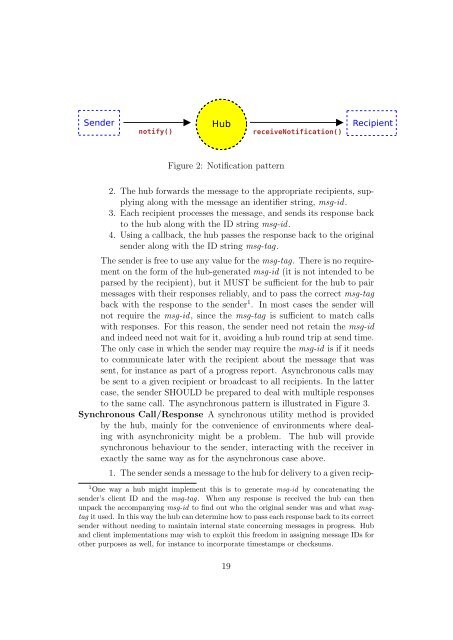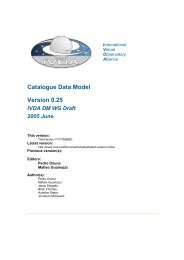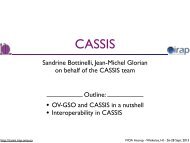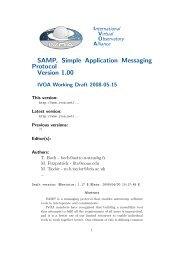SAMP â Simple Application Messag- ing Protocol Version 1.11 - IVOA
SAMP â Simple Application Messag- ing Protocol Version 1.11 - IVOA
SAMP â Simple Application Messag- ing Protocol Version 1.11 - IVOA
Create successful ePaper yourself
Turn your PDF publications into a flip-book with our unique Google optimized e-Paper software.
Figure 2: Notification pattern2. The hub forwards the message to the appropriate recipients, supply<strong>ing</strong>along with the message an identifier str<strong>ing</strong>, msg-id.3. Each recipient processes the message, and sends its response backto the hub along with the ID str<strong>ing</strong> msg-id.4. Us<strong>ing</strong> a callback, the hub passes the response back to the originalsender along with the ID str<strong>ing</strong> msg-tag.The sender is free to use any value for the msg-tag. There is no requirementon the form of the hub-generated msg-id (it is not intended to beparsed by the recipient), but it MUST be sufficient for the hub to pairmessages with their responses reliably, and to pass the correct msg-tagback with the response to the sender 1 . In most cases the sender willnot require the msg-id, since the msg-tag is sufficient to match callswith responses. For this reason, the sender need not retain the msg-idand indeed need not wait for it, avoid<strong>ing</strong> a hub round trip at send time.The only case in which the sender may require the msg-id is if it needsto communicate later with the recipient about the message that wassent, for instance as part of a progress report. Asynchronous calls maybe sent to a given recipient or broadcast to all recipients. In the lattercase, the sender SHOULD be prepared to deal with multiple responsesto the same call. The asynchronous pattern is illustrated in Figure 3.Synchronous Call/Response A synchronous utility method is providedby the hub, mainly for the convenience of environments where deal<strong>ing</strong>with asynchronicity might be a problem. The hub will providesynchronous behaviour to the sender, interact<strong>ing</strong> with the receiver inexactly the same way as for the asynchronous case above.1. The sender sends a message to the hub for delivery to a given recip-1 One way a hub might implement this is to generate msg-id by concatenat<strong>ing</strong> thesender’s client ID and the msg-tag. When any response is received the hub can thenunpack the accompany<strong>ing</strong> msg-id to find out who the original sender was and what msgtagit used. In this way the hub can determine how to pass each response back to its correctsender without need<strong>ing</strong> to maintain internal state concern<strong>ing</strong> messages in progress. Huband client implementations may wish to exploit this freedom in assign<strong>ing</strong> message IDs forother purposes as well, for instance to incorporate timestamps or checksums.19
















